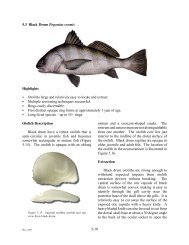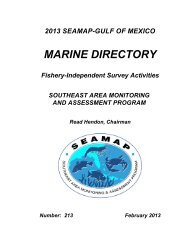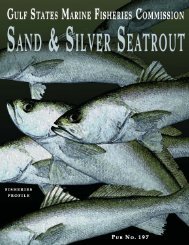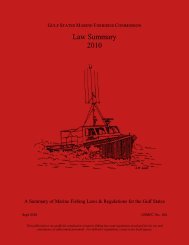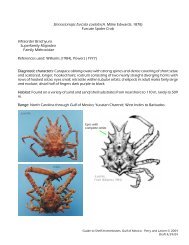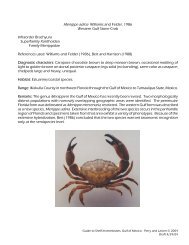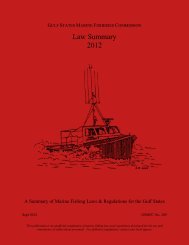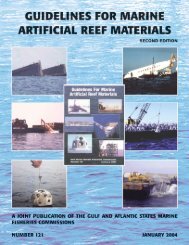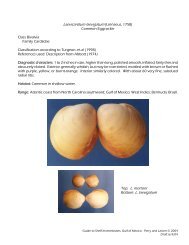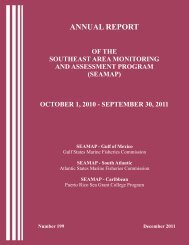Basic Commercial Fishing Regulations - Gulf States Marine ...
Basic Commercial Fishing Regulations - Gulf States Marine ...
Basic Commercial Fishing Regulations - Gulf States Marine ...
Create successful ePaper yourself
Turn your PDF publications into a flip-book with our unique Google optimized e-Paper software.
Other Recreational Activities<br />
24<br />
(whole shrimp per pound). This size<br />
restriction applies to the taking or<br />
possession of such shrimp aboard a<br />
vessel, EXCEPT during the period<br />
from Oct. 15 through the third<br />
Monday in December when there<br />
shall be no possession count on white<br />
shrimp taken or possessed. When<br />
more than 50 percent by weight of the<br />
shrimp taken or possessed is seabobs<br />
or brown shrimp, then the maximum<br />
allowable amount of undersized white<br />
shrimp taken or possessed shall not<br />
exceed 10 percent by weight of the<br />
total shrimp taken or possessed.<br />
Methods of Taking<br />
During open seasons, saltwater<br />
shrimp may be taken with trawls or<br />
cast nets and by no other means. Bait<br />
shrimp may be taken at any time,<br />
even during the closed season, with<br />
cast nets less than 8.5 feet in radius,<br />
hand operated dip nets with a diameter<br />
not to exceed three feet, bait traps,<br />
and bait seines less than 30 feet with<br />
a maximum mesh size of 1/4 inch bar,<br />
1/2 inch stretched mesh which are<br />
A recreational basic fishing and saltwater<br />
license in addition to a recreational<br />
crab trap gear license is<br />
required to use crab traps, with a limit<br />
of 10 traps per licensed fisherman.<br />
Methods of Taking<br />
Crabs or stone crabs may be<br />
taken with any legal crab trap, crab<br />
dropnet, trawl, hoop net, trotline, handline,<br />
bushline, dip net or cast net.<br />
Dredges shall not be used for the<br />
intentional taking of crabs.<br />
The taking of crabs by means of<br />
trawls in inside waters is permitted<br />
only during the open season for<br />
shrimp and with a legal mesh size<br />
(see Shrimp Trawls).<br />
No person shall possess adult<br />
female crabs in the berry stage (i.e.,<br />
carrying the eggs or young attached<br />
to the abdomen). All crabs in the<br />
berry stage taken by any means shall<br />
be returned immediately to the waters.<br />
Gear restrictions may exist within<br />
certain WMAs, refuges or other areas.<br />
Consult your local Wildlife and<br />
Fisheries Office or Enforcement<br />
manually operated on foot only.<br />
Cast Nets, Dip Nets, Bait Seines: A<br />
recreational angler may use dip nets,<br />
bait seines, and cast nets not to exceed<br />
8.5 feet in radius, but shall not take at<br />
anytime more than 50 pounds of<br />
shrimp during closed season and 100<br />
pounds of shrimp per day during the<br />
open season, in the aggregate, per day<br />
per boat or vehicle, regardless of the<br />
number of persons thereon, provided<br />
the shrimp taken are used for bait or<br />
for the fisherman’s own consumption<br />
and are not sold, traded or otherwise<br />
permitted to enter into commerce.<br />
Certain WMAs and state or federal<br />
refuges may have different rules, consult<br />
local LDWF office or<br />
Enforcement Agent for specifics.<br />
(See WMA and Refuge section).<br />
Trawls: Trawls cannot have a mesh<br />
size less than 5/8 inch bar or 1.25<br />
inches stretched. In Zone 2 from the<br />
western shore of the Atchafalaya<br />
River to the western shore of<br />
Vermilion Bay and Southwest Pass at<br />
Marsh Island, mesh size must not be<br />
less than 3/4 inch bar or 1.5 inches<br />
Recreational Crabbing<br />
Agent. (See WMA and Refuge section).<br />
Crab Traps<br />
A crab trap is a cube-shaped<br />
device, constructed of wire, no larger<br />
than 30 inches on any side, and with<br />
either a bait box or materials providing<br />
cover or shelter for peeler crabs.<br />
The entrance funnels must extend no<br />
further than seven inches into the<br />
inside of the trap, with the openings<br />
to the entrance funnels on the vertical<br />
wall of the trap such that the horizontal<br />
diameter of each opening is at least<br />
one and one-half times the vertical<br />
diameter of the opening.<br />
The baiting, tending, checking or<br />
removing of serviceable crab traps in<br />
use, the contents of such crab traps or<br />
their lines, buoys or markers is prohibited<br />
in public waters from one half<br />
hour after legal sunset until one half<br />
hour before legal sunrise.<br />
No crab traps shall be set in<br />
navigable channels or entrances to<br />
streams. Traps must be placed so vessels<br />
can safely navigate.<br />
74<br />
stretched during the fall inshore<br />
shrimp season. No net or beam trawl<br />
used for taking fish or shrimp from<br />
the saltwater areas of the state shall be<br />
left unattended, as defined in R.S.<br />
56:8(102) except such legal nets or<br />
trawls which are attached to a wharf<br />
at a camp and which are tagged with a<br />
department tag issued in conjunction<br />
with the gear being used.<br />
During the open shrimping seasons,<br />
trawls 25 feet and less may be<br />
used for recreational purposes; recreational<br />
shrimpers using trawls 16 feet<br />
in length or less are limited to 100<br />
pounds (heads on) of shrimp per boat<br />
per day, and recreational shrimpers<br />
using trawls exceeding 16 feet but not<br />
exceeding 25 feet in length are limited<br />
to no more than 250 pounds of (headson)<br />
shrimp per day per boat, provided<br />
the shrimp taken are used for bait or<br />
the fisherman’s own consumption and<br />
are not sold, traded or otherwise permitted<br />
to enter commerce. A recreational<br />
trawl license is required.<br />
(See License section for license prices).<br />
Crab traps which are no longer<br />
serviceable or no longer in use shall<br />
be removed by the owner and properly<br />
disposed of or stored by him.<br />
No person other than the licensee<br />
or his agent shall intentionally damage<br />
or destroy serviceable crab traps<br />
or the floats or lines attached thereto,<br />
or remove the contents thereof.<br />
Each crab trap shall be marked<br />
with a two-inch stainless steel self<br />
locking tag attached to the center of<br />
the trap ceiling. Tags shall be supplied<br />
by the fishermen and shall have the<br />
recreational crab trap gear license<br />
number printed thereon. Crabbers are<br />
allowed to use a durable plastic bait<br />
box marker as an alternate means of<br />
tagging crab taps. Crab traps may be<br />
attached to a trotline to which at least<br />
one end is attached to a nonfloating<br />
line and a visible float of at least six<br />
inches in diameter or two-gallon volume<br />
size. Crab traps located in areas<br />
designated as freshwater north of the<br />
northern bank of the Intracoastal<br />
Waterway and west of Louisiana<br />
Highway 70 and those areas located




